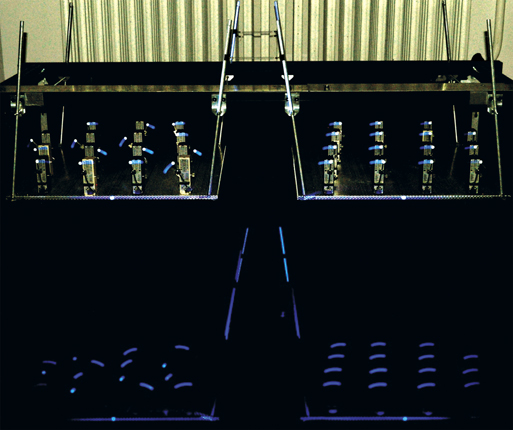A mechanical chimera
DOI: 10.1063/PT.3.2159
The counterintuitive, complex synchronization state known as a chimera was discovered theoretically a decade ago: In an ensemble of coupled oscillators, two incongruous domains, one synchronized and one desynchronized, can coexist even when the oscillators are identical and the system is symmetric. Chimera states made their laboratory debut last year in a pair of experiments—one with optical oscillators, another with chemical oscillators, both exploiting computer-mediated feedback (see Physics Today, October 2012, page 17

Image submitted by Shashi Thutupalli and Erik A. Martens.

On the left, 15 metronomes sit on a swing that, through its left–right motion, couples the metronomes to each other. (It was with a similar setup that Christiaan Huygens discovered spontaneous synchronization nearly 350 years ago.) A pair of springs connects the left swing to an identically loaded swing on the right and provides weak coupling between the two metronome sets. Such nonlocal, nonuniform coupling is key for chimeric behavior. When illuminated with UV light, fluorescent spots on the metronome pendulums leave bright blue trails that, for certain spring constants and metronome frequencies, manifest a chimera state: While the metronomes on one swing tick in unison, the metronomes on the neighboring swing oscillate incoherently. Since the moments of inertia, spring constant, and other mechanical parameters have ready analogues in numerous physical, biological, and chemical systems, the emergence of complex collective behavior may be relevant in diverse settings, from neural dynamics to power grids. (E. A. Martens et al., Proc. Natl. Acad. Sci. USA 110, 10563, 2013. Image submitted by Shashi Thutupalli and Erik A. Martens.)
To submit candidate images for Back Scatter, visit http://contact.physicstoday.org
